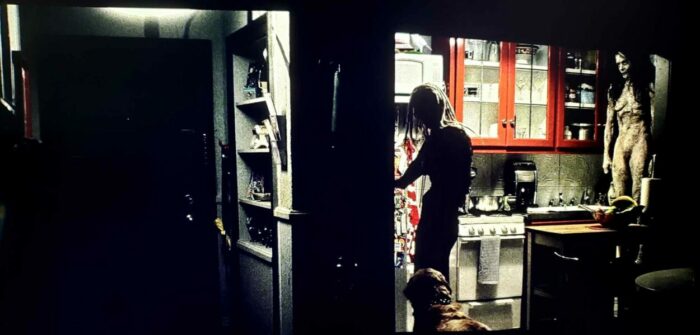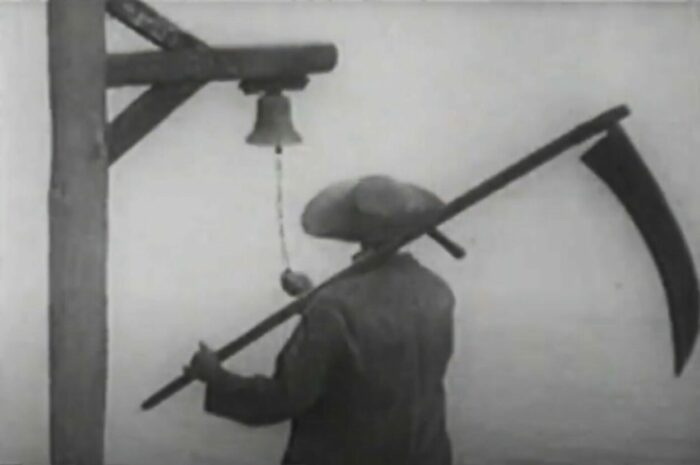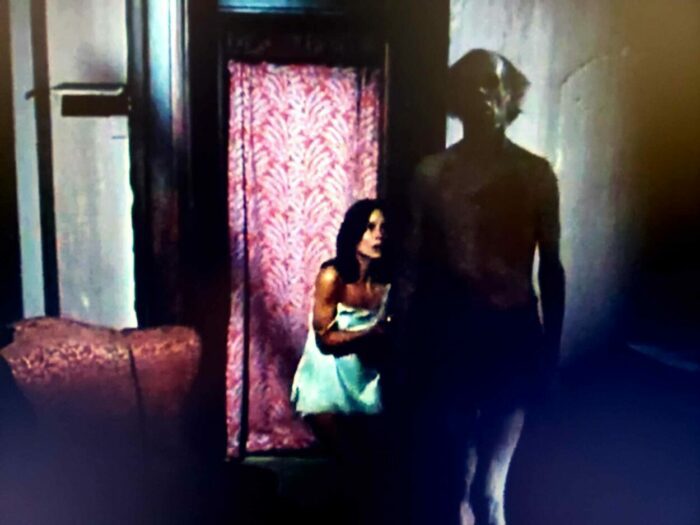Lords of Salem (2012) is an underrated atmospheric experience. Not many movies can conjure dread of a doorway or make a person apprehensive about turning on a light. In fact, illumination is supposed to chase away nightmares, not reveal them. Yet, through quality storytelling and the simplest cinematic tricks writer-director Rob Zombie managed to craft an unsettling tale of psychological manipulation that is as much tragedy as it is terrifying tale.
The film centers on Heidi LaRoc, played by Sheri Moon Zombie. DJ at a hard rock radio station, she receives a strange wooden box from a band called The Lords. Inside is a record, and playing it exposes Heide to an eerie, hypnotic tune. Like a match to fuse wire, the music soon begins sizzling away at her sanity. Horrifying visions which may be physical manifestations not mere hallucinations plague her more and more. Even as it’s revealed witches are manipulating Heidi for Satanic reasons, she’s already spiraling quickly towards a darkness threatening to infect all the women in Salem.
![[L to R] Patricia Quinn, Dee Wallace, Sherri Moon Zombie, and Judy Geeson as Megan, Sunny, and Lacey Doyle and Heidi in The Lords of Salem (2012). Screen capture off Blu-ray DVD.](https://filmobsessive.com/wp-content/uploads/2023/10/380184158_733708315236242_4871658890480917839_n-700x405.jpg)
Not only does this darkness add to the mood of the movie, it becomes part of an implicative metaphor upon any rewatch. Basically, this darkness can be perceived as the presence of the witches saturating Salem. When Heidi is walking to work along shadowy streets, or alone in her dim apartment, the evil is always there with her. And since Lords of Salem could also be viewed thematically as a film about struggling with mental illness as well as drug addiction, a similar message applies. However, when it comes to horror, some simple lighting choices set up amazing scares. One in particular has haunted me since I first saw Lords of Salem in theaters.
(Now, obviously spoiler warning, but, if possible, I strongly encourage anyone unfamiliar with the movie to watch it first. The impact of the unexpected cannot be overrated. Moreover, I’d hate for someone to lose the full hit of this horror.)
The scene is relatively early in the film. At this point, Lords of Salem has established its main characters and villains. The strange music has infected Heidi. Yet, things have only just begun to imply something is off about her reality. In this scene, she returns home to a darkened apartment. The shot shows the door she enters through as well as the kitchen which she immediately goes to. There’s just enough light to understand the setting. When Heidi enters the kitchen, she snaps on a light revealing a grotesque figure hovering in the corner.

It may not sound like much on paper. Visually, though, it’s an unsettling reveal. Even those who may have anticipated someone or something lurking in the darkened corner are still likely to be repelled by that first glimpse of the gruesome entity. Meg Foster is fabulously frightening throughout this film, but here she is, a nude corpse with rotting green flesh simply standing, something wrong about her posture. Meanwhile, Sheri Moon Zombie carries on as if blissfully unaware of this presence. Even her dog Troy has zero reaction.
The result is this implication of a presence inside Heidi’s home. Sinister supernatural forces are within inches of her, and she is completely unaware. Furthermore, with this simple scene, Rob Zombie creates tension for the rest of the feature by suggesting something could be wrong at any given time. Audiences are now aware the darkness permeating the whole picture could be hiding all manner of unsettling entities. It makes a viewer apprehensive throughout.
Saying something is simple can seem to be a pejorative implication. However, complexity doesn’t necessarily denote cleverness. Case in point, there’s a brief anecdote on the commentary for Lords of Salem where Rob Zombie recounts a simple effects solution. One scene required the arm of a record player to drift across the album without catching a track. The FX crew spent a half hour devising ways to manipulate the armature, and while tying filament in order to pull the mechanism, someone suggested simply removing the needle. And voilà. Yet, at the same time, uncomplicated isn’t necessarily easy.

It’s amazing how what seems simple today was innovation in the early days of cinema. Take for instance, the 1932 film Vampyr from Danish filmmaker Carl Theodor Dreyer. Inspired by stories collected in J. Sheridan Le Fanu’s “In a Glass Darkly”, the movie can be described as “a host of stunning camera and editing tricks and densely layered sounds [creating] a mood of dreamlike terror.” However, it’s easy to see how the use of gauze to blur shots, transparent overlays, and shadows implying specters has become hokey over time. Most of the techniques Dreyer was pioneering and experimenting with are plugins people can casually apply to videos nowadays. But that shouldn’t mean losing an appreciation for when it was innovation. Especially since such tricks can still work if done right.
In the 2007 documentary Val Lewton: The Man in the Shadows, Martin Scorsese shows how simple cinematic techniques helped this horror legend turn low-budget features into compelling thrillers. Establishing mood through evocative lighting, setting up story and characters — it all combines into frights which don’t require elaborate effects. Lewton classics such as I Walked with a Zombie (1934) and The Seventh Victim (1943) both create tension so palpable audiences share the dread of the main characters. In some instances, they leave audiences anxious at the sight of empty halls and darkened roads.
The Sentinel (1977) contains a moment similar to the aforementioned one in Lords of Salem. Cristina Raines plays neurotic fashion model Alison Parker. Already unhinged following failed suicide attempts, Alison moves into a Brooklyn Heights brownstone. One night disturbing noises draw her into an empty room. As she hesitantly explores with a flashlight, the door nearby swings aside revealing a rotting corpse who shambles quickly across the room.
Nothing more than a figure behind an already open door. Yet, it’s an unsettling reveal that hits hard—the room is safe and empty until it suddenly isn’t. What’s more, this isn’t a tricky shot to film. That’s the beauty of simplicity.

Even more complicated films benefit from similar reveals. The 2005 British horror film The Descent does a marvelous job of conveying atmosphere while gradually sowing sinister notions. Thrill seekers spelunking in North Carolina caves encounter the terrifying creatures known as the Crawlers. However, the majority of the film is spent establishing the atmosphere of the claustrophobic cave system as well as the dynamic of the main characters. Meanwhile, little hints imply something worse than being lost underground is looming.
The first real glimpse is almost debatable. One could easily understand doubting the sight entirely. Sarah, played by Shauna Macdonald, wanders off on her own, and sweeping her flashlight around briefly spots one of the pale humanoid creatures. Even in a film with elaborate sets and fantastically frightening creatures composed of all kinds of marvelous monster makeup, the first reveal is nothing more than a narrow beam of light moving across a dark cave.
Lords of Salem excels at combining techniques pioneered and perfected over the decades. Simple camera trickery and lighting choices found in expressionist films as well as the works of Dreyer compose a world dripping with evil atmosphere. Establishing story and characters brings the audience into this realm of creeping insanity the same way Val Lewton did with his films. Thus engaged, simple reveals which have been seen since the earliest days of horror up until contemporary classics like The Descent convey without any risk of confusion that something sinister is present. What results is an atmospheric nightmare that can unsettle audiences all the way home.


